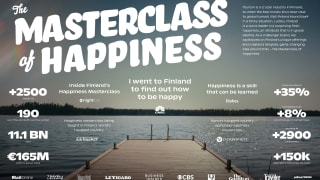The Identity Equation: Creating a scalable place narrative
According to Kirsty McLean, Executive Director Policy, Strategy and Government Relations for Liverpool City Region Combined Authority (LCRCA), “how you talk about yourself… is probably the most important thing to get right in discussions about place.”
People have a complex relationship to place. A person who lives in Altrincham might, for example, recognise themselves as a resident of Altrincham, a Mancunian, and a Northerner. All these identities co-exist independently and yet are inextricably linked. After all, a region is its cities, towns, and often rural destinations combined; and a city is a collection of its diverse neighbourhoods.
The challenge is to reflect this complexity in your brand and your storytelling, without alienating any of your residents or your target audiences. Visitors and investors don’t necessarily see council or geographical boundaries and if you’re on holiday in Devon, there’s nothing to stop you popping over the ‘border’ to enjoy a day on a Cornish beach.
A regional place narrative needs to feel authentically true, but it also needs to allow its cities and component places the breathing space to celebrate their unique identities – ideally in a way that each mutually complements and strengthens the other. We reached out to three of our speakers at this year’s City Nation Place UK conference to hear their advice for how you can present a collective vision for a region whilst still adding value for the destinations within your borders.
Flexibility is essential
It’s a fine line to walk, developing a brand that represents your entire region without coming off overly beige in an attempt to pacify everyone. One key ingredient to achieving this is ensuring that your identity is adaptable enough to be reworked to the requirements of individual places.
“Every place is unique and even at a county level – which our We Are Staffordshire place brand represents – dialects, histories and one’s sense of identity differs, yet we are part of the same defined geographical area,” shared Louisa Shaw, Head of Place Marketing at We Are Staffordshire.
But how does this work in practice?
“The recent ‘It’s in our Nature’ campaign delivered by Visit Kent achieved this effect,” outlined Adam Bryan, Director of Place for Medway Council, explaining that the campaign was built on “a strapline which corresponded with the traditional ‘Garden of England’ line, but one which allowed for flexible local deployment. Manipulating this type of unified brand to bring out the USPs of both larger and smaller destinations is an important device.”
Engagement has to be more than a tick box exercise
You need to have buy-in from your stakeholders and from your fellow place leaders. If they don’t believe in your vision – if they can’t see how it will deliver for their own needs – then you’re already starting on the back foot.
“If the governance is right, representatives from the tourism sector, community leaders and recognisable local businesses could all help build a credibility which will prove to be of benefit to the overall brand approach and to smaller destinations and venues,” recommended Medway Council’s Adam Bryan. “This should be accompanied by connection to local ambassador or champions networks, all of whom will be strategically minded enough to convey a strategic voice whilst having a deep knowledge of the needs of their specific place.”
We Are Staffordshire’s Louisa Shaw has previously spoken with us about the importance of being open and transparent with your stakeholders and bringing them on the journey with you. Acknowledging that you’re prepared to try new things, but to fail fast and to learn from your mistakes is essential to building a trusted relationship with your partners and enabling them to trust in your vision.
As Louisa told us, “by working collaboratively, not only with local authorities but with businesses and attractions, charities, and community groups, education providers and other stakeholders, we can represent the many faces of our county whilst celebrating Staffordshire as a whole, with one united voice.”
Adopt a digital-first approach
The pace of technological innovation is staggering. And as more innovations continue to come to market, many of these solutions are becoming more affordable for places who are looking to experiment with new technologies.
“Whether this is to signpost visitors to routes, events or tour itineraries or being around using a variety of social media and new bespoke applications to reach a variety of audiences online, innovation in the use of digital tech is a vital component of any modern and fit-for-purpose approach to marketing the place,” shared Medway Council’s Adam Bryan.
As generative AI and other emerging technologies continue to shape the way that we interact online, more opportunities will be opened up for destinations looking to develop a flexible umbrella strategy for their place.
However, for it to be successful, your strategy has to be rooted in an authentic story about your place. As LCRCA’s Kirsty McLean explained to us, “bringing the city region together under one banner is about creating a sense of place that is not about borders but about brilliant stories and exceptional people.”
We look forward to hearing from our line-up of exceptional place leaders at City Nation Place UK this September 19th to learn more about how places are breaking down silos and identifying new avenues for collaboration.









